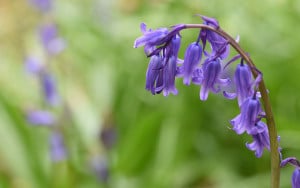The English bluebell is a popular pick, with the dainty, blue, nodding flowers that bloom in spring. Their presence brings a magical woodland feeling to the area. Find out how to grow bluebells in your garden best.
The English bluebell, or Hyacinthoides non-scripta has recently hybridised with Hyacinthoides hispanica (Spanish bluebell). This mix has led to more vigorous growth than the native type which could lead to the English bluebell dying out eventually.
Planting bluebells
Bluebells are often seen growing in partial shade under trees, but are actually what is known as woodland edge plants and can tolerate full sun or full shade in a well-drained soil. Well-suited to growing beneath deciduous trees, they will get the shade in spring and summer when the trees are in full leaf, and sun in the cooler months when the leaves have fallen.
They look lovely grown naturalised in grassy areas. To create that naturalistic look, plant small clumps together, at irregular intervals. Throw the bulbs randomly and plant them where they land for random positioning.

Plant ‘in the green’ bulbs in the ground, at the same depth as they were before. ‘In the green’ means when the plants are in active growth and still have their leaves. When planting this way, late spring is the best time.
For dry bulbs, these should be planted in autumn in a hole at least 10cm deep, with the growing tip facing upwards.
Dividing the plants

From May to July, bluebells can be divided and replanted, after flowers and before the leaves die back.
Another way of increasing the number of bluebells in your garden is to leave the stems on after the plant has finished flowering and collect the ripe seeds later in the year – sowing them immediately in compost. Germination can be erratic and take a long time, but it’s worth trying, especially if you’ve got a large area to fill on a budget.
When bluebells are growing amongst grass it’s important not to cut the grass until after the leaves of the plant have completely died back. This is usually about 6 weeks after flowering finishes.
Also, be sure not to cut off the foliage when flowering has finished as the plant needs the leaves to process sunlight and transport resources back down to the bulb underground so that it will flower well the following year.

Leave A Comment